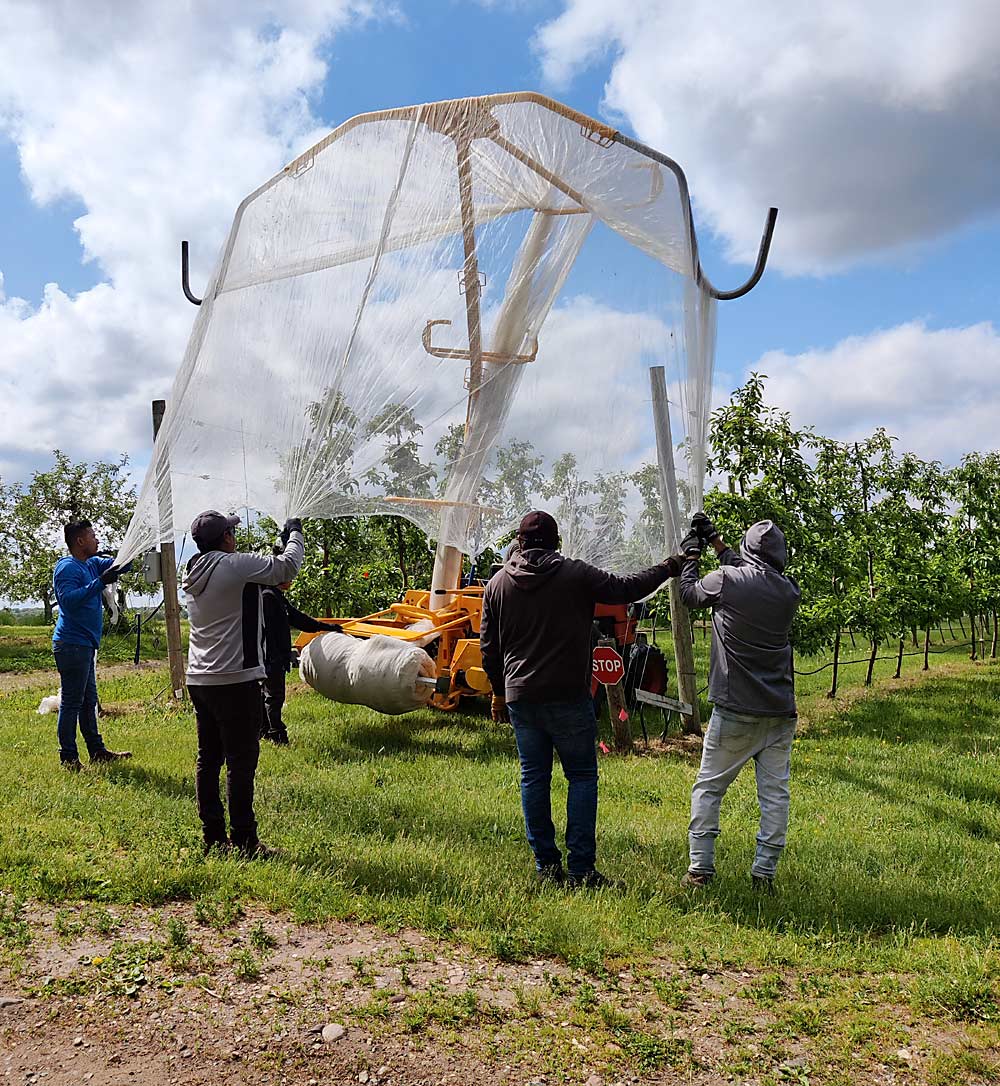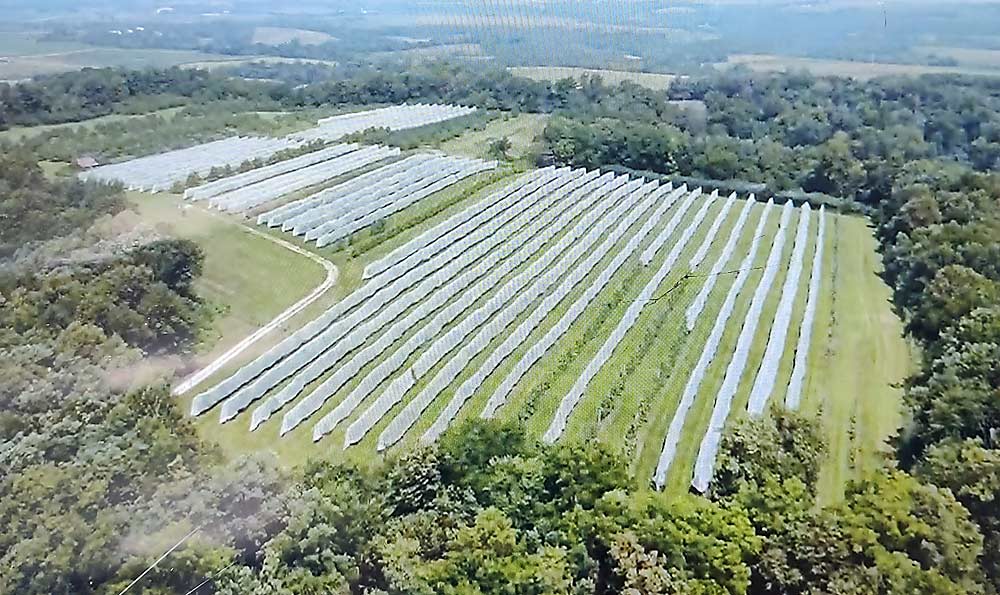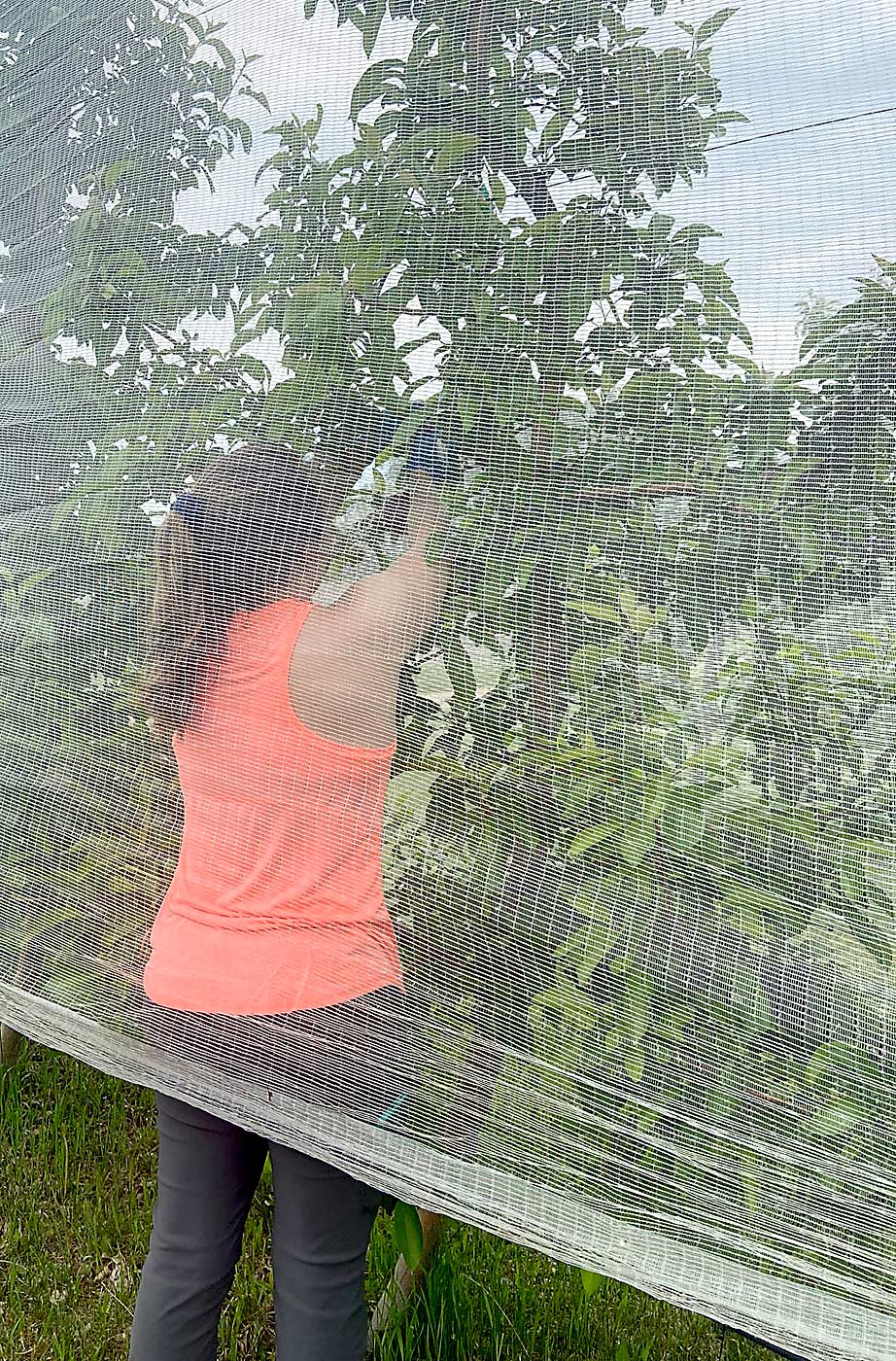
Hail netting can protect apples from more than hail. It can also shield trees from pests, according to a recent University of Minnesota study. The two-year study found that standard commercial hail netting essentially eliminated two major pest species — codling moth and apple maggot — from apple trees in a commercial orchard.
UMN professor and extension entomologist Bill Hutchison had been studying insect netting as a nonchemical alternative to battle spotted wing drosophila in raspberries and wine grapes. His findings led him to become a proponent of the practice for those applications, but he hadn’t considered it as an option for orchards until 2020, when he stopped at John Jacobson’s Pine Tree Apple Orchard in White Bear Lake, about 20 miles northeast of Minneapolis.
A golden opportunity
Jacobson, a former president of the Minnesota Apple Growers Association, is a known innovator, Hutchison said.
“I saw that he had put hail netting on many, many rows of his apple trees, especially his most valuable apples like Honeycrisp and SweeTango,” Hutchison said of one visit to the farm.

Jacobson had also installed hail netting on trees in his other orchard operation in Preston, in southeastern Minnesota. After seeing firsthand how well the netting worked during a hailstorm, he has added hail netting to more acreage every year.
Hutchison took one look at the hail netting and its mesh size of 6 mm by 1.5 mm, and he immediately recognized its potential as a barrier for a prominent apple nemesis: the codling moth. At the same time, UMN extension educator Annie Klodd had been making her own regular stops at Jacobson’s orchard and had a similar notion about the hail netting as a possible pest-blocker.
The two researchers saw Jacobson’s orchards as a golden opportunity to test the impact of typical hail netting within commercial farm operations, so after gathering some promising preliminary data in the summer of 2020, they put together what would become a successful grant proposal to the Minnesota Department of Agriculture to test their hypothesis. With the grant in hand, Hutchison’s graduate student, Sally Nelson, prepared to carry out the study during the 2021 and 2022 growing seasons.
For the study, the farm set out its hail netting as usual. This included using a specialized, tractor-drawn implement to drape the netting after petal fall, leaving the netting in place for the summer, and then removing it just before harvest. Nelson then spent the season placing, replacing and checking insect traps for codling moth and apple maggot flies, as well as for redbanded leafroller. In all, she monitored four rows in each of seven experimental blocks at the two orchards over the two years. Each block had four treatments: netted and open rows each receiving the standard pesticide regimen, along with netted and open rows that went unsprayed.

Pests “down to nearly zero”
Neither orchard experienced heavy pest pressure in 2021 or 2022, but the netting still showed striking benefits. For all three species, Hutchison said, “the netting without any sprays at all was the top performing treatment over everything else, including the insecticide sprays.”
Across both years and with all traps averaged, the netting reduced the number of apple maggots caught by 96 percent, codling moths by 94 percent, and redbanded leafrollers by 56 percent, Nelson reported.
“The amount of reduction we’ve seen is amazing,” she said. “It basically cut the codling moth and apple maggot down to nearly zero.”
So far, Hutchison thinks hail netting makes good sense.
“I would say it’s something that more growers should consider,” he said. “I really do see it as a win-win not only for hail protection, but also for pest management now that we have two years of data in Minnesota — three years, counting our preliminary data — showing that hail netting consistently suppresses codling moth and apple maggot.”
More results to come
Before he will wholeheartedly recommend hail netting to apple growers, however, Hutchison is waiting for the results of two other parts of the study still underway. For the first, UMN applied economists are conducting a cost/benefit analysis, weighing such variables as frequency of hail events and related damage costs, with and without netting; pesticide use; potential labor costs with and without netting; and the cost of netting and installation. That analysis will likely continue through the summer of 2023.
For the second, Nelson set out yellow sticky traps to note any differences in nontarget invertebrate visits to the trees in the trial. She has already identified such beneficials as minute pirate bugs and parasitic wasps (Trichogramma species) among the tens of thousands of invertebrates in the traps, and she is now working with taxonomists at the U.S. Department of Agriculture to sort through the remainder and complete the analysis.
In the meantime, growers seem intrigued by hail netting as a nonchemical insect-suppression tool, said Nelson, who has already presented the pest-suppression results at a major entomology conference last summer and at various grower meetings.
“When I go to grower meetings, people ask a ton of questions and are really interested,” she said. “It makes me feel like I’ve been spending time doing something that is actually important information for people.”
—by Leslie Mertz
Colorado experience shows payoff of pest-netting approach
Five years ago, frustrated by high codling moth losses in his organic apple orchards, one Colorado grower started to wonder about the moth-blocking potential of hail netting. He visited a New York grower using DrapeNet and liked what he saw.
“I was getting a bit desperate, and I just took the plunge,” said Jamie Weyndling, who owns Honeycrisp Orchard in Hotchkiss, Colorado. “Low and behold, the next year we had virtually zero codling moth damage.”
Given the 50 percent losses he experienced the year before, the $100,000 investment in netting and equipment paid for itself the first season, he said. Plus, he now skips the codling moth virus sprays that don’t seem to offer as much control as they used to.
“We start to put it out right after petal fall. It takes a few weeks to get it up,” Weyndling said. The netting stays up until a few days before harvest. “You have the labor cost of putting it on and taking it off, that’s kind of a wash with the materials savings, but we’ve got it fairly well down to a fine art of getting them on and off.”
For thinning, his crews untie the bottoms and work inside the nets. He’s also found the nets reduce water demand slightly, and fruit still color well. Weyndling expects to get a few more years out of the nets before they require replacement.
His initial success caught the attention of his neighbors in the Rogers Mesa region of Western Colorado, where organic production is the focus for a handful of commercial farms.
It also attracted the interest of Ben Bentele, a research horticulturist at the Colorado State University Organic Agriculture Research Station at Rogers Mesa. With a grant from the Colorado Department of Agriculture Specialty Crop Block Grant Program to address the region’s codling moth challenges, Bentele compared netting to the region’s standard organic codling moth control practices using mating disruption, CYD-X (codling moth granulosis virus) and Entrust (spinosad) at five orchards, starting in 2020.
“I love this research because it was grower-driven. Growers took the risk, made the investment, and we just followed along to get the data,” he said.
Netting at five sites reduced codling moth trap counts significantly and reduced rates of codling moth damage to below 5 percent, a marked improvement to the over 70 percent losses some were experiencing.
“Because the damage here is so high, the ROI is easy,” Bentele said.
He suspects codling moths in the region have developed resistance to CYD-X, but that has yet to be confirmed by laboratory testing. The IPM that worked for decades started failing around 2017, he said.
“We’re surrounded by abandoned and unmanaged orchards, but that’s no scapegoat,” he said. “You can’t spray the same thing every week without risking resistance.”
This year, Bentele plans to continue the research looking at the secondary pest implications, as he has seen woolly apple aphid flare-ups under the nets for most cultivars except Honeycrisp, look at multiple types of netting, and see if the netting can be used to block pollinators to manage crop load.
“It’s a lot of labor to go under the nets for thinning work,” he said.
—Kate Prengaman






Leave A Comment